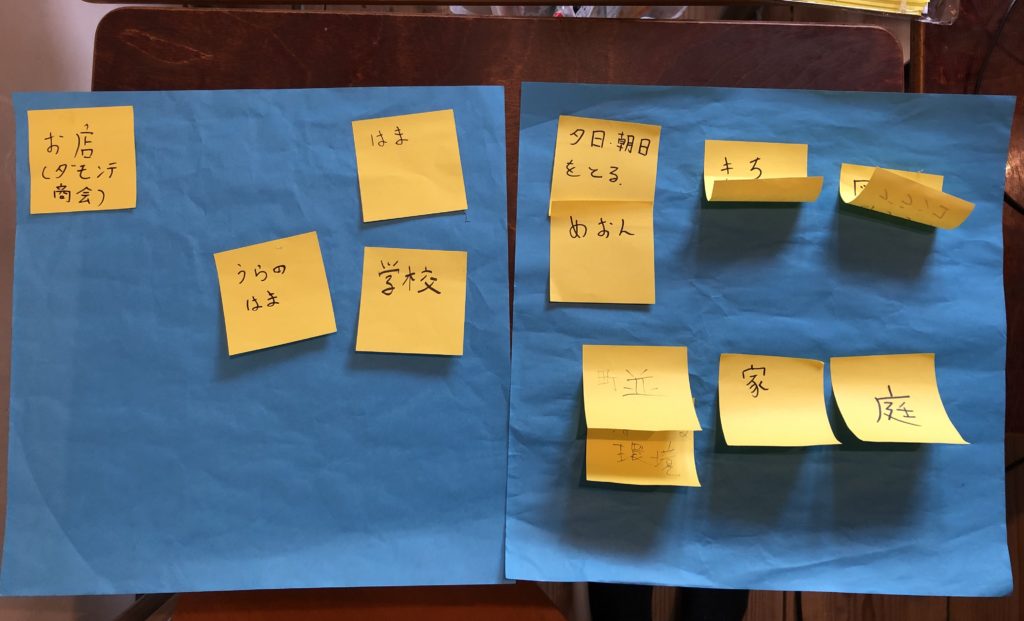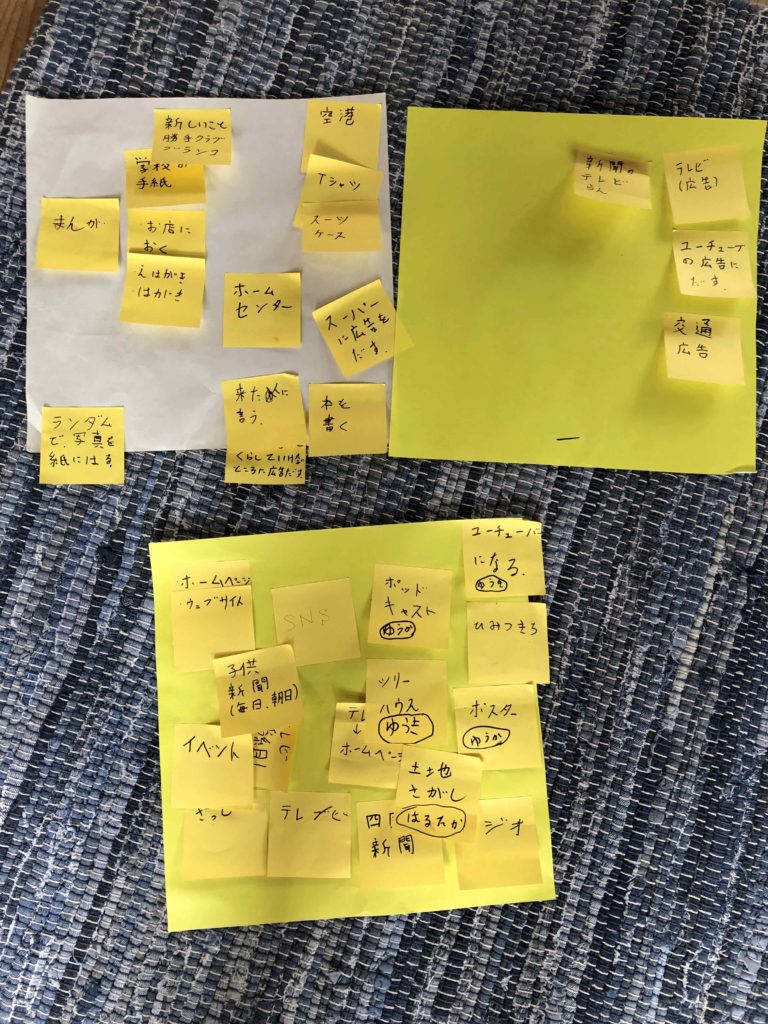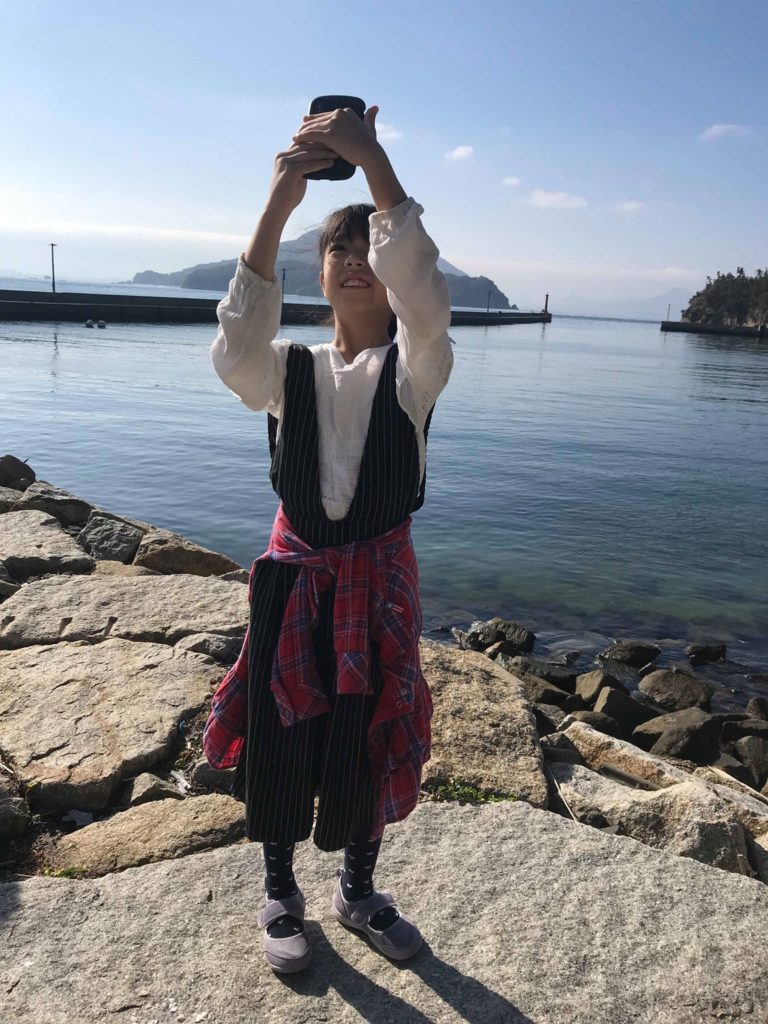This blog post is originally written in Japanese. For an English translation, please scroll down. Thank you!!
11月22日(金)〜24日(日)までの3日間、教育プロジェクトの第1回目が子供たちとともに行われました。この日のために保護者では計画の話し合い(第1回プロジェクト「珍百景さがし+ビデオ制作」に決定 )を行ってきたわけですが、実際に行われたのは子供たちが考えた「子ども目線での楽しい男木島の場所」をGoogle ストリートビューのカメラを使った360度のVR写真撮影でした。
当初の計画は「珍百景探しとビデオ制作」でしたが・・
流れとしては、前回の記事にもある以下の流れを考えていました。教育プロジェクトとしてはじめての取り組みなので、子供たちが飽きる前に達成感を味わってもらおうということで、短期間で集中的に、そして最後にはビデオ映像が一つ出来上がるという流れです。
1 子どもたちがチェキを使って島内の写真を撮る
2 子どもたちで話して、写真を選定
3 ビデオを作るための構成・セリフを考える
4 撮影
5 編集
6 上映
特に気をつけたところ
プロジェクトを行う上で特に保護者の間で時間をかけて話し合ったのが、動機づけです。やらされてる感を無くすことや楽しいと感じる感覚、さらに継続力をつけるためにはこの動機づけが肝だと感じたからです。話し合いの結果、子どもたちには「なぜこの教育プロジェクトが始まったのか」「保護者は何を思っているのか」を共有せずには、3日間集まる意味が子どもも見いだせないという結論に至り、素直に「男木島に住む子どもがもっと増えればいいと思っていて、そのために楽しいことをしていきたいと思っている」ことを伝えることになりました。
上の計画の1点目「写真を撮る」の前に、この話をし、同時に「子どもたちはどう思う?子どもが増えたらどんなことがあるかな?どんな子に引っ越してきてほしい?」といったことを聞く時間を20分ほど取りました。高学年の子は日頃から同じような年齢で共通の話題が話せる友達がほしい、と話していたこともあったり「本の貸し借りをしたい」、低学年の子は「子どもだけでサッカーしたい、とにかく皆で外で遊びたい」などといった意見が出ました。
全員が同じ土台に立ったところで、じゃあ子どもが引っ越してくるためにはどうしよう、という話へ。
1日目-「動機づけ+男木島はどんなところ?」
「男木島に引っ越してくるためには男木島について知らないといけない。男木島はインターネットではどんな場所として描かれているのであろう?」という疑問を投げかけ、パソコンを打てる子がインターネットで男木島を検索。そこで見た画像や映像から男木島に子どもがいる家族が引っ越してくるためには、何が足りていないのか、何が必要か、男木島の何が良いのかを話し合いました。
1つのメモに1つのアイディアを書きます。話し合いをしているカーペットの上では他の子の意見を批判しない、遮らないというルールづくりもしました。
次から次へと出たアイディア
- 子どもが過ごす時間が多い学校内をもっとアピール
- 毎日遊べる(放課後遊べる、みんな家が近い)
- 車の数が少ないから自転車のコントロールが上手じゃなくてもいい
- 放課後の過ごす時間がゲーム以外にも選べる
- 高松にはあるようなホテルが少ない。気軽に短期間お試しに住める家がない
- 秘密基地がある
- 木が余っているので、木のゲームをつくる
また、この日、会の名前が保護者が考えていた「放課後クラブ」から、子どもたちが何もしても良いという意味で子ども発案の「勝手クラブ」に変わりました。
2日目-「子ども目線での楽しい男木島の場所」をVRで撮る
この日は東京在住の小中学生2名が合流。前日出た子ども目線での楽しい男木島をテーマに、子供たちがどの場所の写真を撮れば良いのかのリストアップを行います。これも同じくメモでドンドン書いて、ドンドン紙に貼っていきます。

子どもたちが挙げた男木島の楽しい場所
- お店(子どもたちが常連のカフェ・ベーカリー「ダモンテ商会」)
- 浜
- 裏の浜
- 学校
- 夕日・朝日
- めおん
- 町並み
- 家
- 庭
- 秘密基地
- 図書館裏のブランコ
10箇所ほど場所が出たところで、今回は残り2日間しかないので、どう効率的に子供の人数を分けて撮りに行くのかの話し合いが行われました。これにも色んな意見が出て、15分ほど話していたのではないでしょうか。インテリ派と行動派に分けるなど、ワイワイ言いながら決めていました。
結果、携帯で連絡を取り合う可能性を考慮して、携帯を持つ子どもと、さらに撮るものの島での位置関係を考えて2班に分かれることに。計画当初、撮影はチェキを使ってアナログ式にしようと考えていましたが、急遽参加してくれた楠田亘さん(roboticsなどの設計や開発、講師を行う株式会社フレップテックの代表取締役)の発案でVRに挑戦することになりました。事前に今回の主な会場であった男木島図書館内で360度の写真を撮る方法を教わり、いざ外へ。
途中、電池切れで図書館に戻ってくるハプニングもありましたが、40分ほどで撮影が終了し、図書館に再集合。2日目の最後には、それぞれが撮った写真をパソコンの画面で確認して、終了。自分が撮ったものを見るのは楽しかったようで、「人が入ってると写真がピッタリつながらなくて難しいね」など撮影方法の学びもありました。
3日目-男木島にもっと子どもが増えるための方法を考える
再び昨日撮ったVR写真をパソコンで確認しながら、撮ったものを1日目に話した「子どもをもっと男木島に増やすためには」の方法論を話し合いました。大人としてはVR写真をインターネット上に上げてSNSで拡散、または子どもが好きなYouTubeに投稿してそれを紹介するビデオをつなげたら、などやはりインターネットという答えが真っ先に思い浮かぶのですが、子供たちからは意外にもインターネットは出ません。
代わって出てきたのが、こんな回答でした。
- 漫画
- 写真を冊子にする
- DIY好きの家族は男木島に来るかもしれないので、ホームセンター
- スーパーに広告を出す
- 日本だけでなく海外の人もターゲットに入るので、空港によく出入りするスチュアーデスのスーツケースに広告を貼る
- 本を書く
- 学校の手紙の配布物に広告を入れる
- 絵葉書をつくる
- ホームページをつくる
- 男木島でイベントをする
- 子ども新聞に広告を出す
- ポスターをつくる
- ツリーハウスをつくる

最後のほうで、1日目に出ていたSNSというメモを大人が持ってくると、YouTuberの意見がようやく出ました。それだけ子どもにとってインターネットは日常になっているということかもしれません。
これらのアイディアをさらにお金がかかるものと、そうでないものに仕分けて、今すぐできることとしてお金がかからなくてやりたいことをそれぞれが選んでいきました。最後には、ツリーハウスを作りたいと言った子が早速土地探しに出かけていき、それに続いて全員外へ飛び出していき、3日間に渡った第1回目はそのまま終了へ。
この他にも、2日目の最後には、急遽日没と夜空の観察会が開催されました。子どもたちも掲げていた「家が近くて集まりやすい」「ゲーム以外をする選択がある」といった男木島ならではの過ごし方です。
第1回目を終えての振り返り
人の意見を聞く姿勢は、その場の雰囲気を作るときに大事
特に子供の場合、他の人が話している最中に自分が思ったことをその場で言ったり、「でも〜」と反対意見を言ったりすることが多いのですが、今回はグループで一緒に作業しているので、話している人の顔を見る、人が話している間は話を遮らない、批判的なコメントはしないという条件をルールとして伝えました。年齢差のある小学1〜6年生が一緒に話し合う上では、あえてルールを作るのはその場の雰囲気を崩さない、発言しやすい環境をつくるためには大事でした。
走りながら新しいものが生まれる
教育プロジェクトは、新しい教育の方法を学校や地域と連携して取り組んでいくというゴールがあって生まれた活動ですが、こうした活動に興味がある大人や親がつながっていくことによって、より豊かな教育の場をつくりあげる過程がみれました。おそらく、今後子どもたちがそれぞれやりたいことを進めていくときにも、同じように共感してくれたり、応援してくれる子ども・大人が寄ってきて、手伝ってもらうことによって、動機づけや継続力が強化されていくのではないかと感じました。
The first project for “Ogijima, Future Education” Project was held with the children for three days over the weekend of November 22 to November 24. For this weekend, the parents had discussed the plan, but the outcome of the first project came out different from our plan. Instead of filming video, the children took 360 degree photos using a Google Street View camera to shoot fun places on Ogijima through kids eyes.
The original plan was “hunting unique scenes and then video production” …
For the process, we were thinking of the flow in this previous article. This is the first effort as an educational project, so it was created to be a short weekend project that allowed the children to get a sense of accomplishment before boredom set in. It was designed as intense, but short term; and ending with a finished video.
1. Children take pictures of the island using instant cameras
2. Discussion and photo selection
3. Think about composition and lines for making videos
4. Video shooting
5. Editing
6. Presentation/ Video Screening
Where we were particularly careful
Motivation has been the subject of several discussions with parents, in particular, the children’s motivation during this project. The parents felt that this motivation was the key to feeling pride, having fun, and the ability to continue (GRIT). As a result of the discussion, we came to conclusion that the children would find the project more meaningful if we first talked about why this educational project started and what concerns parents have. So, we told them that we would like to have more children living in Ogijima and that we would like to do fun things to resolve the concern (this project being one of those fun things).
We talked about this the at the very beginning, and at the same time asked the kids “What do you think? What would happen if the number of children increased? What kind of children do you want to move to Ogi?” We probably took around 20 minutes to discuss. Older children had already talked about wanting friends the same age who can talk about the same topics, and some also mentioned “I want to lend and borrow books with friends.” Others said, “I just want to play outside” and ” I’d like to play soccer game with just kids”.
Once everyone was on the same page, we then moved on … how to solve the issue with action.
Day 1 – Motivation and What is Ogijima?
To move to Ogijima, you have to know about Ogijima. So we decided to search on the internet to see what kind of place Ogijima is depicted on the internet. A child who could use the PC searched Ogijima on the internet, and after seeing what images and videos were shown, we discussed it together. We talked about what was missing, what was necessary and what was good for Ogijima in order for the families with children to move to the island.
Ideas were written on small post-it notes. We also established a rule not to criticize other children’s opinions on the carpet while we were discussing.
Children’s ideas after searching Ogijima on the internet
- There is very little available about the school, where children spend most of their time
- There are not many hotels. There is no house where a family could come stay for a short period of time
- Since there are more trees, make a tree game
- Kids on Ogijima play every day (you can always play after school, everyone’s house is nearby, within walking distance)
- You don’t have to handle your bike well, because there are hardly any cars
- You have more choices for what to do after school than staying home playing games on computers or other devices
- There is a kid’s secret base
On the same day, the name changed from “after school club”, which parents thought of , to “勝手クラブ” (which translates as sort of “my own way” club). This was chosen by children with thought that children can do anything.
Day 2- Taking virtual reality (VR) of fun places on Ogijima through kids eyes
On this day, two elementary and junior high school students from Tokyo joined. Based on the theme “the fun on Ogijima from the child’s perspective” that came out of the day before, we listed places where the children could take photos.
Fun places on Ogijima that children mentioned
- Shop (Café bakery “Damonte.co” where children are regulars)
- Beach
- Back beach
- School
- Sunset / Asahi
- Meon
- Townscape
- House
- Garden
- Kid’s secret base
- Swing behind the library
There were about 10 places on the list and by this time we were already part way through the second day with limited time left. So there was a discussion about how to efficiently divide the group and where to go for taking photos. There were various opinions and children discussed about 15 minutes.
As a result, they decided to contact one another with a cell phone, and to divide into two groups, as well as spliting the locations of the things to be photographed on the island. At the beginning of the plan, the parents were considering using an instant camera, but because of the last minute participation of Mr. Wataru Kusuda (representative of Hreptech, who designs and develops robotics, etc.) the kids decided to try virtual reality (VR). The children were taught how to take 360-degree photos in advance at the Ogijima Library, which was the main venue for this event.
At the end of the second day, kids checked the pictures they took on computer. They seemed to enjoyed seeing the photos they took, and some learned the tips for taking a good 360 photo.
Day 3-Thinking of methods to increase number of kids on Ogijima
While confirming the VR photos taken yesterday on a computer, we discussed the methodology of “How to increase children to Ogijima” which we talked about on the first day. As an adult, the answer to the internet comes to mind first, such as uploading VR photos on the internet and spreading it on SNS, or posting a video that introduces it to YouTube. Surprisingly, internet didn’t come up until an adult took out a memo stating ‘SNS’ written from the first day.the day before, we discussed the methodology of “How to increase children on Ogijima” which we talked about on the first day. As adults, the answer of “internet” comes to mind first, such as uploading the VR photos on the internet and spreading it on social media, or posting a video to YouTube. Surprisingly, internet didn’t come up with the children at all until an adult took out a note stating ‘social media’ written on the first day.
Other answers came out instead
- Manga
- Make a photo booklet
- DIY-loving families may come to Ogijima, so advertise at home improvement stores
- Advertise in supermarket
- Since not only Japan but also international people will be the target, put advertisements on stewardess suitcases that often go in and out of the airport
- Write a book
- Place advertisements in school letter distribution
- Make a postcard
- Create a homepage
- Have an event on Ogijima
- Advertise in children’s newspapers
- Make a poster
- Make a tree house
We divided these ideas into those that cost more and those that didn’t, and each chose what they wanted to do as soon as possible. The child who wanted to make a tree house went out to find the land immediately, and then all went out, and the first project was finished.
As a special addition, at the end of the second day, there was a sudden sunset and night sky observation session. This is a way of life unique to Ogijima that children had already mentioned, such as “homes are close and it is easy to gather” and “ You have more choices for what to do after school than staying home playing games”.
Review after the first round
Listening to others’ opinions is important when creating the atmosphere
As a rule, we told them that they look at the person who was speaking, not interrupt the person while speaking, and not making critical comments. Many children especially have the tendency to talk while others are talking, say what they thought on the spot, or say “but…”. However, with kids through first to sixth grades, we felt it was important to have this rule so that we could create an atmosphere in which everyone could speak and everyone would be heard.
New things are born while running the project
This project was created with the goal of working with schools and communities in different ways of education. Throughout the planning phase, we were able to connect with adults and parents interested in these topics, making our goal easier to reach. As we move into the next phase of this project, the children may also meet more children or adults who are sympathetic and supportive, and as a result strengthen their motivation.

